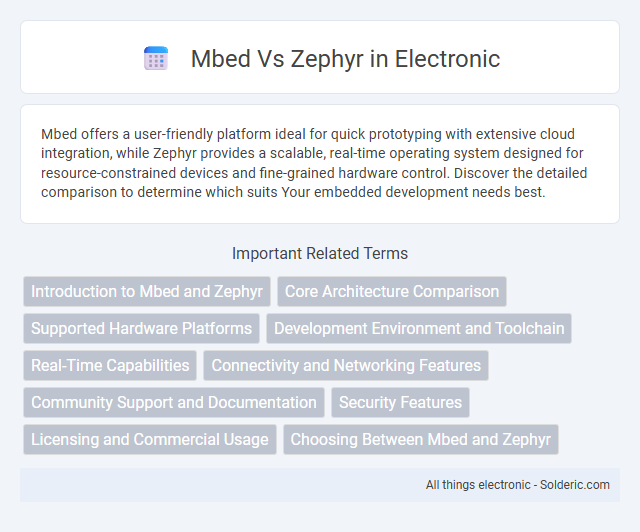Mbed offers a user-friendly platform ideal for quick prototyping with extensive cloud integration, while Zephyr provides a scalable, real-time operating system designed for resource-constrained devices and fine-grained hardware control. Discover the detailed comparison to determine which suits Your embedded development needs best.
Comparison Table
| Feature | mbed OS | Zephyr OS |
|---|---|---|
| Developer | Arm | Linux Foundation |
| License | Apache 2.0 | Apache 2.0 |
| Target Devices | 32-bit ARM Cortex-M MCUs | 32-bit and 64-bit MCUs, including ARM, x86, RISC-V |
| Kernel Type | RTOS-based | Real-time microkernel |
| Supported Architectures | ARM Cortex-M (M0, M3, M4, M7, M33) | ARM, x86, RISC-V, ARC, Tensilica, Nios II |
| Development Environment | mbed Studio, online compiler, Arm Keil | Multiple IDEs, native build tools (CMake, West) |
| Connectivity Support | Bluetooth LE, LoRaWAN, Ethernet, Wi-Fi (via modules) | Bluetooth LE, Thread, Wi-Fi, Zigbee, LoRaWAN |
| Community & Ecosystem | Strong Arm ecosystem, mbed Developer Community | Active open-source community, Linux Foundation backing |
| Security Features | Secure boot, PSA Certified components | Secure boot, Trusted Execution Environment (TEE) |
| Use Cases | IoT, wearables, low-power embedded applications | IoT, industrial automation, wearable devices, aerospace |
Introduction to Mbed and Zephyr
Mbed is an open-source IoT platform designed by Arm, providing a comprehensive ecosystem including an RTOS, development tools, and a rich library for ARM Cortex-M microcontrollers. Zephyr, hosted by the Linux Foundation, is a scalable, real-time operating system designed for resource-constrained devices across multiple architectures such as ARM, x86, and RISC-V. Your choice between Mbed and Zephyr depends on the target hardware, community support, and specific IoT application requirements.
Core Architecture Comparison
Mbed OS features a modular, layered architecture optimized for Arm Cortex-M microcontrollers, emphasizing real-time capabilities through its RTOS kernel and hardware abstraction layers. Zephyr OS offers a highly configurable, scalable kernel designed for diverse architectures beyond Cortex-M, with a focus on multi-threading and ultra-low power applications. Your choice depends on whether you prioritize Mbed's Arm-centric core or Zephyr's flexible, cross-platform kernel architecture.
Supported Hardware Platforms
Mbed OS supports a wide range of ARM Cortex-M microcontrollers, including platforms from STMicroelectronics, NXP, and Nordic Semiconductor, making it ideal for IoT and embedded applications. Zephyr OS offers broad hardware compatibility beyond ARM Cortex-M, including RISC-V, ARC, and x86 architectures, supporting devices from vendors like Intel, NXP, and Nordic. The diverse hardware platform support of Zephyr provides flexibility for complex, multi-architecture projects, while Mbed's optimized focus on ARM Cortex-M ensures streamlined development for resource-constrained devices.
Development Environment and Toolchain
Mbed OS offers a cloud-based development environment with an easy-to-use online compiler and supports ARM Keil, IAR, and GCC toolchains, promoting rapid prototyping and seamless integration. Zephyr provides a flexible development environment primarily based on west and CMake, compatible with multiple IDEs such as Visual Studio Code and Eclipse, and emphasizes extensive support for standard debugging and build tools across various architectures. Both platforms enable cross-platform development, but Mbed's cloud platform caters more to beginners, whereas Zephyr's toolchain is favored in complex, multi-platform industrial applications.
Real-Time Capabilities
Zephyr OS provides robust real-time capabilities with a deterministic kernel designed for low-latency task scheduling and precise interrupt handling, making it suitable for time-critical embedded applications. Mbed OS offers real-time features through its event-driven scheduler and hardware abstraction, but its latency performance is generally less predictable compared to Zephyr's real-time priority-based preemptive scheduler. Developers targeting stringent real-time requirements often prefer Zephyr due to its more advanced support for real-time threading, priority inversion handling, and fine-grained timer management.
Connectivity and Networking Features
Mbed OS offers robust connectivity options including built-in support for Bluetooth Low Energy, LoRaWAN, Wi-Fi, and Ethernet, optimized for rapid IoT development. Zephyr integrates extensive networking protocols, such as IPv4, IPv6, 6LoWPAN, and Thread, alongside native support for Bluetooth, Wi-Fi, and CAN bus for versatile device communication. Both platforms emphasize secure and scalable networking capabilities, but Zephyr's modular architecture allows more granular control over stack components, enhancing flexibility for complex network topologies.
Community Support and Documentation
Zephyr offers a broad and active community backed by the Linux Foundation, ensuring extensive support and regularly updated, comprehensive documentation suitable for diverse IoT projects. Mbed OS, maintained by Arm, provides detailed documentation and a large developer community, with numerous examples and forums focusing on ARM Cortex-M microcontrollers. Your choice depends on project requirements; Zephyr's support for multiple architectures contrasts with Mbed's strong ARM ecosystem integration.
Security Features
Mbed OS offers hardware-based security features such as secure boot, root of trust, and PSA-compliant security architecture to protect IoT devices from threats. Zephyr OS integrates extensive security mechanisms including kernel-level privilege separation, stack protection, and encrypted storage, with support for secure firmware updates and OS-hardening techniques. Your choice depends on the security requirements of your embedded project, as both platforms provide robust but distinct approaches to safeguarding connected devices.
Licensing and Commercial Usage
Mbed OS operates under the Apache 2.0 license, providing permissive terms that favor commercial product development with minimal restrictions. Zephyr is licensed under the Apache 2.0 license as well, enabling flexible use in proprietary and open-source projects, but it includes contribution requirements. Your choice between Mbed and Zephyr should consider licensing compliance to ensure smooth commercial deployment and integration.
Choosing Between Mbed and Zephyr
When choosing between Mbed and Zephyr, consider your project's hardware compatibility and ecosystem requirements, as Mbed offers extensive support for ARM Cortex-M microcontrollers with a user-friendly online compiler, while Zephyr provides a highly modular and scalable solution supporting diverse architectures including x86 and RISC-V. Your decision should factor in real-time operating system features, community support, and licensing, with Zephyr often preferred for complex industrial IoT applications and Mbed suited for rapid prototyping and development focused on ARM hardware. Evaluating development tools, middleware availability, and long-term maintenance needs will ensure the best fit for your embedded system project.
mbed vs zephyr Infographic

 solderic.com
solderic.com